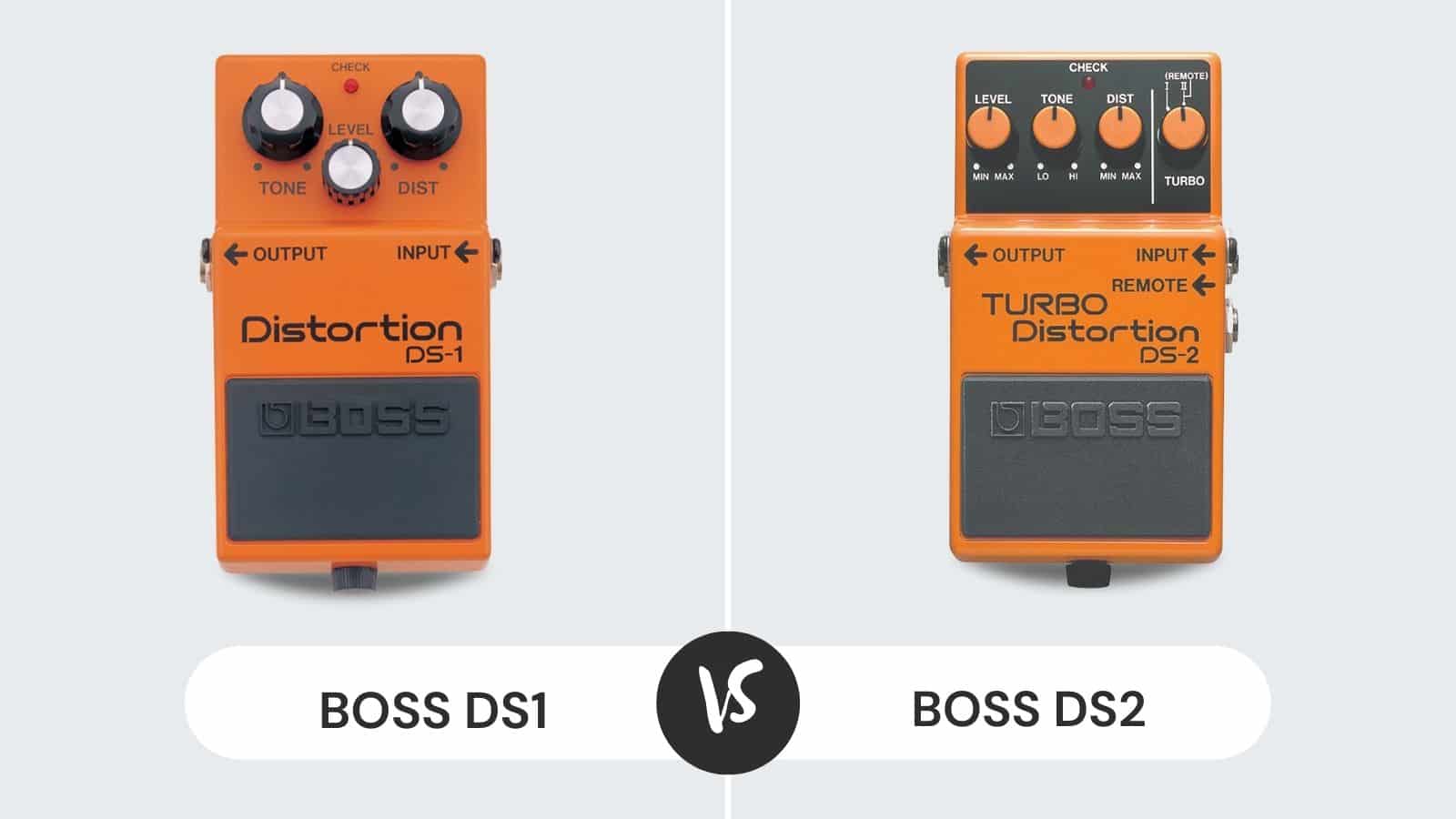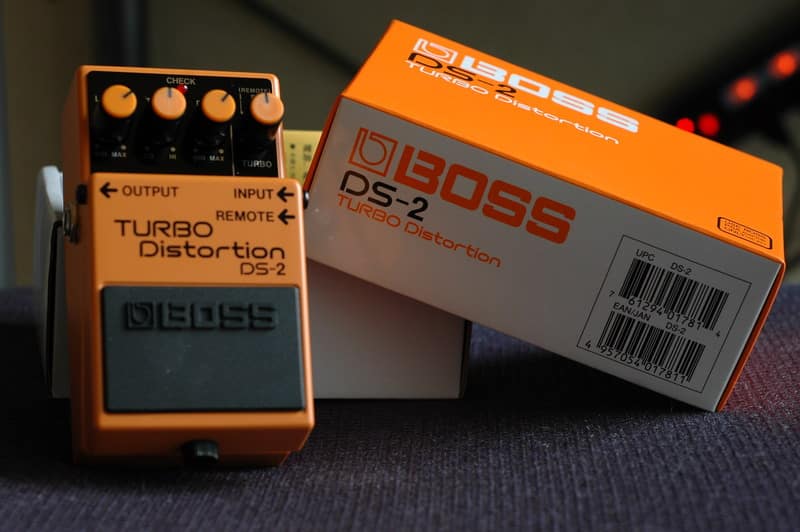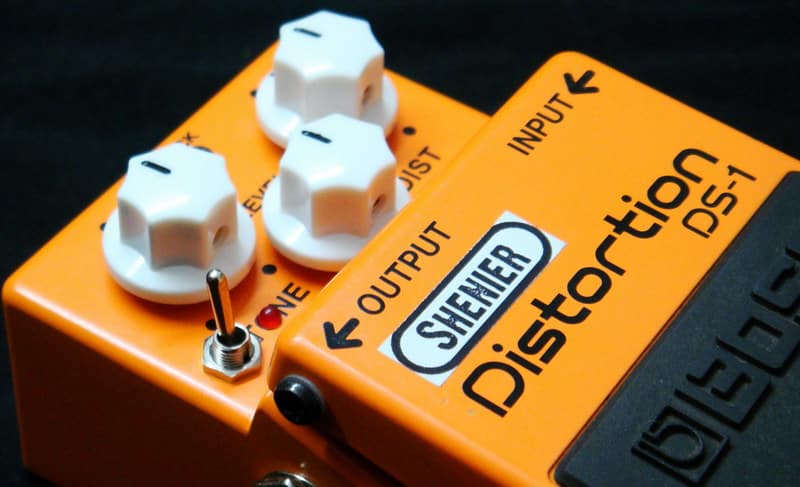
Founded in 1973, Boss has come a long way in manufacturing guitar effects pedals. There is a popular Japanese music brand, a Roland Corporation, of which Boss is a part.
One cannot imagine the music industry without the Boss gear. Taking a look at the history shows that some of the great musicians of all time used this gear.
Most guitarists face confusion between Boss DS-1 and DS-2 when making a choice for the guitar pedal. The reason is that the two of these iconic pedals are somewhat difficult to distinguish.
A comparison between them on the basis of specs, pricing, features, tone, etc., can help you pick the pedal that best suits your needs.
Boss DS1 vs DS2 Comparison Overview
At a Glance
| Features | Boss DS-1 | Boss DS-2 |
|---|---|---|
| Power Supply | 9V DC | 9V DC |
| Turbo Mode | No | Yes |
| Remote Input | No | Yes |
| Color | Darker Orange | Lighter Orange |
| Weight | 400g/ 0.88 pounds | 400g/ 0.88 pounds |
| Dimensions | 7.3 x 1.29 x 5.9 cm | 7.3 x 1.29 x 5.9 cm |
Comparing The Tone
If you look at the modes of the two Boss pedals, you will see there is one mode on Boss DS-1, but there are two modes on DS-2. The presence of two modes on DS-2 enables the turbo to switch on it.
The switch doesn’t necessarily have to be on. It can be off as well. The function of the turbo switch is to add a midrange boost to the DS-2 and add to its versatility.
The Turbo switch is the key factor that gives a different kind of tone to DS-2. One can detect noticeable differences in the sound produced by Boss DS-1 and DS-2.
Sound
The sound coming from DS-1 is gritty and overdriven, while the distortion resulting from DS-2 is smooth and heavy.
The sound of DS-1 is quite great with low gain. Its distortion tone is classic and gets its link from the 70s and 80s. Instead of a pure distortion, there is an overdriven aspect to the sound. If you have mistaken the sound of DS-1 for the driven Marshall tube amp, you are not the first.
The DS-2 sound is perfect with high gain. There is more treble and midrange, which gives a punchy touch to the tone. The loudness of DS-2 is more than that of the maximum level achieved by DS-1. The distortion variation of DS-1 is narrow, while DS-2 has a broad distortion range.
Most of the guitar communities are always in the debate about which pedal sounds the best. Truth is said, it all depends on your personal preference.
In a nutshell, you can get the most out of DS-1 sounds at low gains that are saturated enough to produce a crunchy sound. On the other hand, the sounds of DS-2 are good for leads. You can get the best out of DS-2 sounds at high gain.
The Controls
Both DS-1 and DS-2 pedals get on the same page in terms of having a tone, level, and distortion control. However, the DS-2 has an additional turbo control that is responsible for boosting the mid-range by giving an extra mode to the pedal. You can either use a remote or achieve this manually.
There are two options to control the turbo mode. One of them involves the control of the pedal and its adjustment. The other one requires the use of a footswitch.
The switching between the two modes is promoted by the connection of the footswitch with the help of input on the pedal. You can easily switch to the lead sections with the turbo switch, thanks to its midrange boost.
Lead guitarists utilize most of this feature on the stage when they have to make a quick tone change.
The controls on both the DS-1 and DS-2 pedals have the same job. The level control controls the volume. The distortion control brings a balance in the level of gain. The management of bass and treble frequencies is done by tone control.
If you turn the dial to 0, you will boost the bass and bring a reduction in the treble. You get an increased treble and reduced bass if you set it to the maximum.
Feature Comparison
There is a feature of the gain knob that concerns the variation of the saturation level with the adjustment of the gain knob.
When you analyze the saturation level in DS-1, its variation is narrow and small, unlike the DS-2, which has an expanded range of saturation levels. This is why DS-2 produces thick and heavy distorted signals.
Specs And Pricing
If you look at the price range of the two pedals, there is a clear difference. The absence of turbo mode on the DS-1 makes it a cheaper option to rely on. The basic stats of the DS-1 do not affect its perfectly distorted tone.
The major reason behind the popularity of DS-1 is its cheap pricing. When you look at the astonishing features of this pedal, the price seems really low for its quality distortion.
There are some people for whom guitar pedals might be new. They can benefit at large from DS-1. The same is true for someone who is trying to get their first distortion effect.
The quality of DS-1 is quite satisfactory for more advanced players. Although DS-1 is not as versatile as DS-2, you can still use the tone of DS-1 in genres ranging from blues to metal.
Other Differences
The sound of DS-1 is quite thin, which makes it a perfect fit for classic rock and blues. You can also use it for the mild distortion genres. Without any significant punch, it remains thin even when the distortion is rolled all the way up.
The tone knob does have areas that can give stale sounds, while others have a balanced and crystal clear tone. Regardless, it’s a classic pedal that can successfully meet the needs of a lower end distortion pedal.
When it comes to the punch of DS-2, it packs it. The maxed distortion results in punchy sounds. There is more thickness and fullness associated with DS-2 when you compare it with DS-1.
Another intriguing thing about DS-2 is its large range for the volume, level, and tone. With a little turn on the knob, you can switch from the mild distortion to a loud sonic assault. It’s the tone knob that gives you the brassy tones once and then the trashy ones.
Conclusion
Both the Boss DS-1 and DS-2 pedals offer everything for rock lovers and modern metal. In terms of versatility, the Boss DS-2 turbo wins over the DS-1, thanks to its turbo switch that has the job of boosting the mid-range.
On the other hand, DS-1 is capable of producing a wider range of distorted tones, being a perfect fit for blues and classic rock.


